
17 minute read
Two Shield seniors reflect on their high school career and the tolls of their college application process in a letter of advice to their younger selves
I’m sick of nic regulation shield the
ALEX DOWD copy editor
This new law changing the smoking age to 21 isn’t going to be as effective as the government hopes it will be.
I’m a senior in high school. I’m 17, one year away from becoming an adult. In under six months, I can live on my own, get a tattoo, vote, be sued, serve on a jury, become a notary public, sky dive, fight and die for my country and pose fully naked in the centerfold of a magazine. Becoming 18 marks a new chapter in life where I have near full autonomy over myself and my actions. I can legally do almost anything that isn’t causing harm to others … except smoke.
On Dec. 20, President Trump signed a government-funded bill that included a new age limit on the sale and possession of tobacco and nicotine products.
The law went into effect the same day, and it’s failure to include a grandfather clause, left many young adults forced to face panic and withdrawal. Though lawmakers, lung doctors and the entire #truth staff rejoiced in this subjective victory, the potentially life-altering effects of this new law were nearly completely looked over.
For starters, people are already addicted. According to a central Massachusetts experiment performed by the Center For The Advancement Of Health, a nicotine addiction forms very quickly due to its ability to release excessive dopamine in the brain, overwhelming the brain’s receptors and forcing them to work at an accelerated rate even when nicotine isn’t present.
It takes about two to four weeks for a young adult to become addicted to nicotine and only a few days for a dependence to form. An addiction that occurs so quickly and forcefully is hard to boot, especially with the looming threat of a harsh withdrawal period standing in the way of sobriety. Smokers between the ages of 18 and 20 were blindsided by this government-forced withdrawal. Now, an action that was built into their schedule is a crime that could get them fined and enrolled into a Tobacco Awareness Program. For nicotine addicts under 18 that were already abusing nicotine illegally, little to nothing has changed. Their actions were and still are illegal, but that didn’t stop them before and therefore, won’t stop them now. Fake IDs exist. If you have the right connections, you can be any age that you want. A new age limit won’t reduce the amount of people vaping, it will just reduce the amount of people vaping legally.
Reducing nicotine and tobacco’s legality presents a whole new problem for smokers. Now, if they are caught in possession of a nicotine product, they’ll suffer legal consequences that will affect their personal records. Once we, as a country, go down this path of restriction, we are falling down a slippery slope.
Here’s a situation that current high school students can relate to: A student in their senior year is in possession of a product containing nicotine (pick your poison, cigarette or puff stick or whatever) and they’re confronted by an officer. What would have been a frisk with no consequences, is now a chargeable offense. This student will be put into the government system 13 feb. 2020
THE STRANGEST THING is that cigarette ads are illegal under Article 13 while vaping ads don’t have the same restrictions. Graphic by Anna McClellan.
and now, on their college applications, and later, job applications, they will be required to state that they have been in legal trouble. With this box checked, they could be denied scholarships, federal aid for loans and even admission to schools. These consequences already exist for even the smallest nonviolent drug-related crimes. Nobody is being hurt except for the person ingesting the nicotine or tobacco, and they are more than likely aware of the damage these chemicals will do to them. By creating legal trouble for nonviolent, not even drug-related crimes, the futures of talented, intelligent students are jeopardized.
If the goal of this law is to reduce the amount of young people addicted to nicotine, which it is, this is far from the most effective solution. Most kids who smoke or vape get these products from their peers, not from a corner store or smoke shop, and those who do buy directly, have ways around showing real age identification.
I agree, the amount of kids addicted to nicotine is definitely concerning. I’m friends with people under 18 who have full-fledged nicotine addictions, people who smoke a cigarette or hit a Juul when it’s convenient, and people who have fully sworn off of all nicotine products (which doesn’t mean you’re better than anyone else, it just means you can probably hold your breath for longer). Every single one of those people recognizes that smoking and vaping are both bad for you, but no one has a concrete idea of how to stop this nicotine craze from spreading and how to reverse its effects.
If we truly want to end teen nicotine addiction, restriction isn’t the answer. Keep the age at 18, where it has been since 1984. Legal adulthood should present kids with more freedom and even subjective “danger.” Let’s stop demonizing children who are experimenting, finding themselves and trying to grow up.
The real villains who should be targeted are the tobacco and nicotine companies who are profiting off of the illness of addiction. We shouldn’t make nicotine products less accessible; we should make them less desirable.
Though cigarette ads and commercials are illegal under Article 13, electric cigarettes and vapes don’t have the same restrictions. Take away these companies’ abilities to advertise their products.
opinion 29 With no way to get the word out, nicotine product companies won’t be able to alert the public of new products or price changes, slowing their wildfire-like spread and notoriety. You can’t smoke what you don’t know about.
In addition, their advertising should be banned from online platforms so social media influencers can’t promote these dangerous products to their younger audiences.
The government should instead replace these ads with warnings about the dangers of tobacco. We’ve all seen these and know that they’re relatively ineffective, but prior to a #truth ad that I saw starring puppets, I, along with many of my friends, was under the impression that vaping was better for you than smoking. Turns out, that is false. Thank you, knock-off Muppets. For the privatized side of the United States, or businesses, create more smoke-free spaces and include all nicotine devices. The more inconvenient smoking is, the less likely people will be to take it up.
Let’s face it, as teenagers, many of us are looking for convenient vices to help us get through our final years as a “child.” We aren’t really known for going far out of our way to get a new drug with minimal effects: that tends to happen after the addiction has formed. So companies, do your part!
I don’t think that this age change is going to be successful and the harm it will cause clearly outweighs the good.
On behalf of teenagers and young adults in the United States, do you think changing the alcohol age to 21 stopped underage drinking? Because I know it didn’t.
Context is everything shield the
Out of context, once innocent commonly used hand gesture can now have serious consequences
The commonly used “OK” hand symbol can be defined as many things, depending on who you ask. It is used to check one’s scuba gear after entering the water and in yoga to symbolize inner perfection. In basketball, the “OK” symbol is used by referees to signal that a shot attempt has been released beyond the three-point arc and is worth three points if it goes in.
When the basketball teams took their team pictures, two players, one on the boys team and one on the girls team, made the hand symbol in order to celebrate their ability to make long-range shots worth three points. When the girls banner was installed in the gym, the issue of the hand gesture and its contested meaning became a controversy.
This matter is a difficult one to come to terms with for three reasons.
The first and most obvious one is that the students who made the hand gesture clearly did not mean to convey anything other than to celebrate their ability to make 3-point shots on the basketball court.
The second is that the recent history of the hand gesture is very problematic. The hand sign has been used over the last three years to symbolize the letters “W” and “P” for white power, first in a successful social media hoax and then just as an expression of straight-up hatred.
The third issue is that there were communication breakdowns throughout this controversy. An original concern was raised, and the girls banner went up before that concern was addressed. Complaints were raised when the district considered taking the banners down, and they were not adequately answered.
It was clear at the meeting on Jan. 31 that people were upset not just about the banner decision but about how the decision was made. The district basically apologized for the communication gaps and for not having a clear policy in place for approving team banners and promotional banners before they are approved and installed. The promised new district policy will undoubtedly prevent another public controversy over promotional posters in the future.
And that’s a good thing. The larger question of whether the hand gesture should be permitted in a promotional banner would have been much less contentious if such a policy had been in place.
Those that argue in favor of the removal of the banner have just reasoning. The “OK” hand symbol, when taken out of context, can have a sinister and seriously offensive meaning. The New York Times identified its origins as a hate symbol to a 2017 campaign started by a few 4-Chan users to trick people into believing that the “OK” symbol was now a white supremacy symbol. The campaign worked, and was furthered as white supremacists adopted the symbol to convey their racist beliefs.
The symbol, however, has long had meanings not related to white supremacy. Besides it’s far-reaching use in basketball, the hand gesture has also been
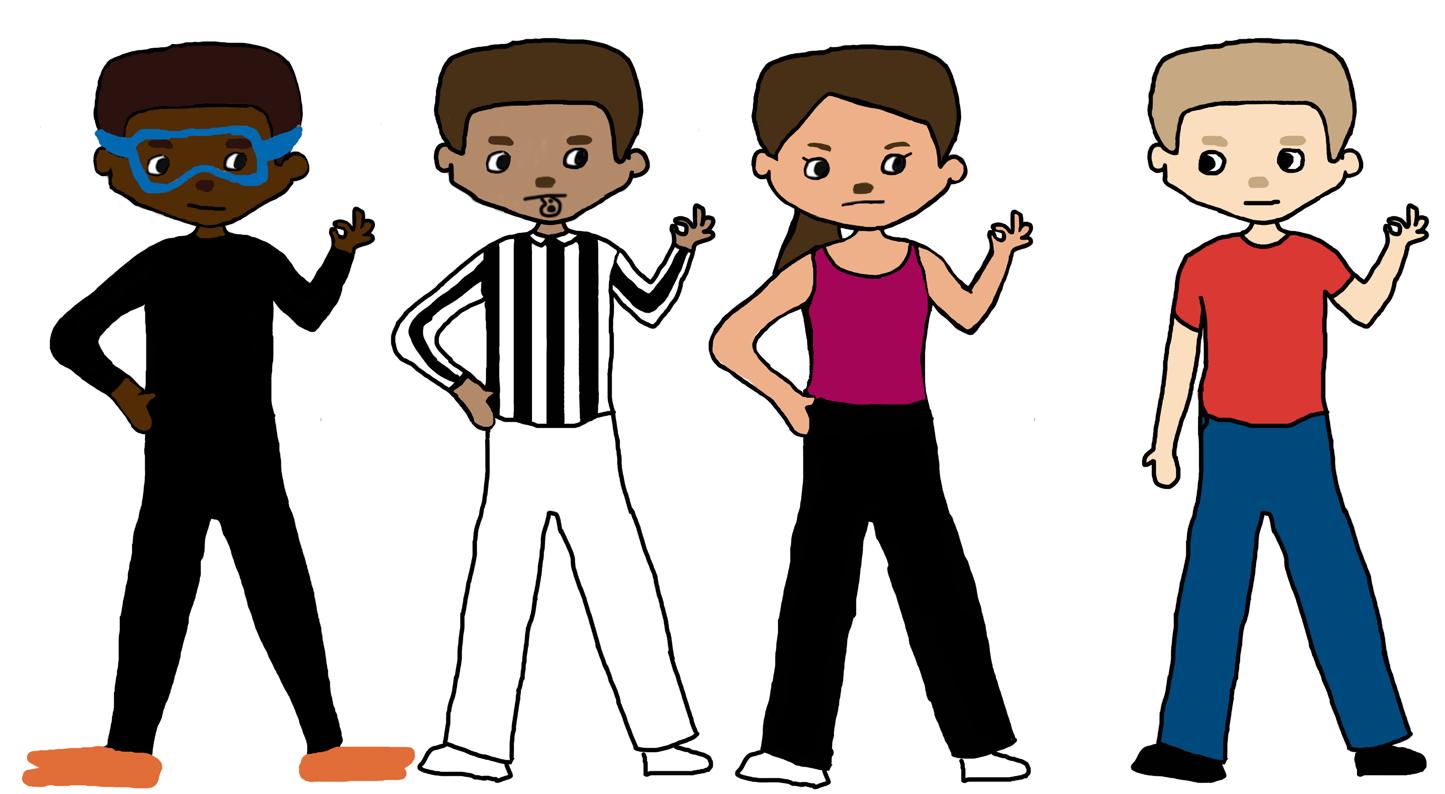
used simply to convey that everything is OK.
The Anti-Defamation League has urged that people use caution when evaluating what the symbol is meant to convey.
“Because of the traditional meaning of the ‘okay’ hand gesture, as well as other usages unrelated to white supremacy,” the ADL writes on its website, “particular care must be taken not to jump to conclusions about the intent behind someone who has used the gesture.”
Since the gesture conveyed a clear basketball message in a basketball context, the symbol’s usage in the posters should be understood as a basketball symbol not a hate symbol.
Even if someone walked into the gym and saw the symbol without knowing what its usage meant, they could assume the symbol conveyed a basketball meaning.
Those who have argued in favor of replacing the banners with gesture-free alternatives are fueled by concerns that the symbol could be misunderstood as a symbol promoting hate, and reflect negatively on the individuals who used them.
It is true that taking down the banners was an effective method to prevent future misunderstanding, but the censorship itself also reflected negatively on the team. By admitting that the gesture has multiple meanings and choosing to remove the banners, the district inadvertently prescribed the hateful meaning to the symbols in the banner. Removing the banners implies that the players had something to hide, and that the symbol’s meaning was not as debated as it was full on shameful.
Leaving the banners up may have caused some debate, but at least the players could have pointed to their actions and justified them with context. Since the banners are now removed, the players are represented by the fact that their banner was taken down, not by their fight to educate people on what they feel the 3-point sign should mean.
The bottom line is that this symbol was not originally created out of hate. To compare it to a swastika or a Confederate flag is disproportionate solely because of the extreme gravity these other hateful symbols carry. History is important when weighing the pros and cons of the banner’s removal. The use of the symbol to convey a white power message is relatively recent compared to its other meanings. Banning the symbol and removing the banner is essentially allowing white supremacists to steal the gesture’s meaning. The rest of the world should not have to change their definition of a positive gesture because of a hate group.
The best way to go forward as a community is to listen to each other and to learn how to differentiate between intentionally hateful images and unlucky coincidences. To take down the banner and ban the symbol draws more attention to hate groups, as well as villanizing the students in question.
As a community, we must focus on eradicating hate when it is intentional, and not on taking actions out of the context that justifies them.
shield the staff
A.N. McCallum High School 5600 Sunshine Drive Austin, TX 78756 (512) 414-7539 fax (512) 453-2599 contact.macshield@gmail.com
assistant editors editors-in-chief KRISTEN TIBBETTS AND JANSSEN TRANSIER
adviser DAVE WINTER ALEX DOWD, ELLEN FOX, MAX RHODES, BELLA RUSSO, ELISHA SCOTT, SARAH SLATEN, MIA TERMINELLA reporters
ALYSA BIJL-SPIRO, OLIVIA CAPOCHIANO, KATHRYN CHILSTROM, GRAYSON CRUISE, EVELYN GRIFFIN, COHEN JOHNSON-DYE, LASZLO KING-HOVIS, LUCY MARCO, TOMAS MARRERO, ANNA MCCLELLAN, CALEB MELVILLE, ASLY MENDEZ RUIZ, JESSICA MONTOYA-MORENO, MADELYNN NILES, GRACE NUGENT, SAMANTHA POWERS, JULIA KAY SMITH, KAYCEE STROTHER, ISABELA TAPPERSON, GRACE VAN GORDER, JAVIER VELA, KENNEDY WEATHERBY, LOKI WILSON
The Shield is published by journalism students in the newspaper production class. Although students work under the guidance of a professional faculty member, the student staff ultimately determines the content.
Students may not publish material that is obscene, libelous or that which will cause a “substantial disruption to the educational process.” Content that may stimulate heated debate is not included in this definition.
The Shield operates as an open forum for exchange of ideas. Opinions expressed in editorials are the ideas of the staff. Opinions expressed in the columns are that of the writer’s alone.
Letters to the editor are encouraged and must be signed. Positive identification may be required when a letter is submitted. Letters may be edited.
Letters that are critical of the newspaper staff’s coverage of events or that present information that may stimulate heated debate will be published.
Letters that contain malicious attacks on individual reporters, the adviser or the principal will be rejected.
Anyone interested in purchasing an ad should contact adviser Dave Winter at (512) 414-7539. Ads published in The Shield do not necessarily reflect the opinions of the staff.
The Shield is a member of the Interscholastic League Press Conference, the National Scholastic Press Association, the Columbia Scholastic Press Association and the Southern Interscholastic Press Association.
Photo by Alex Dowd
Knights’ quest for 10th straight district title and beyond

Photo by Grace Nugent
macshieldonline.com check out
From city council to U.S. Senate?

Photo by Christopher K.Nelson reprinted under the Creative Commons Public License. Inspired by Bryant’s legacy, Knights mourn his death
share the shield

Like us on facebook.com/MacJournalism
Follow us on Twitter @macstudentmedia
Follow: @macjournalism on Instagram
Black History Month at McCallum shield the


Featherstone, Moore elevate student voices, African American experiences in presentation EXCERPTS FROM AN EXPERT: For the sixth straight year, Dr. Leonard Moore, a U.S. History professor at the University of Texas, spoke at the Black History Month presentation to teach students about the history of race in America. Dr. Moore was invited by the event’s main organiser Larry Featherstone, and was followed by a panel of student speakers who had also helped to organize the event. Photo by David Winter
FIRST A LISTENER, NOW A PRESENTER: .As a student panelist following Moore’s speech, sophomore Tracy Atoo spoke on the challenges she faces being the only student of color in some of her Pre-AP classes. “I always have to prove myself that I belong in the PreAP classes,” Atoo said. Afterward, Atoo felt that the presentation was a success, and served as an eye-opener to some of the audience members. “This was a very important presentation for me because I feel like—not everybody—but a good chunk of the kids and adults at school are pretty ignorant on the issues that we face being black in America,” Atoo said. “It’s important that they can see our daily struggles and possibly understand and be sympathetic.” Photo by Regan Sims. SPREADING UNDERSTANDING: Senior Jaylen Wilbourn worked towards “knowledge and empathy” by speaking on the differences between black youth and their peers, representation of people of color, and how to recognize and acknowledge differences. “We live in a world where everybody is different and [we’ve] all been through different things,” Wilbourn said. “We have to be aware that we see things in a completely different way and the world sees us in a different way. Just recognize that everyone has different experiences and respect it. “ Photo by Regan Sims.
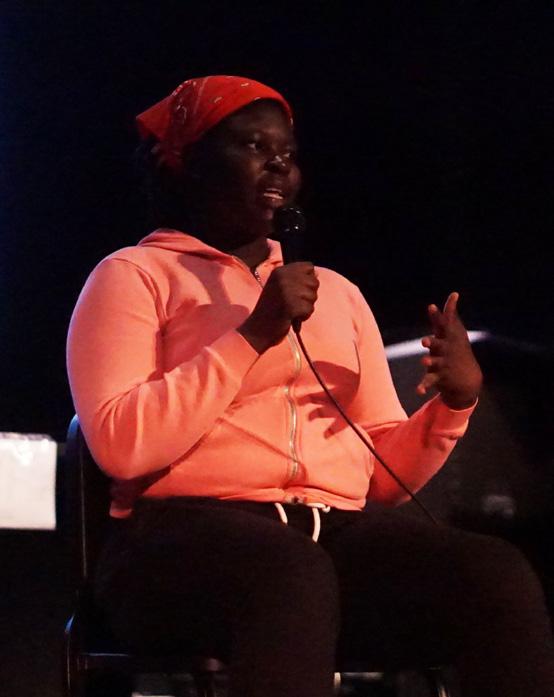
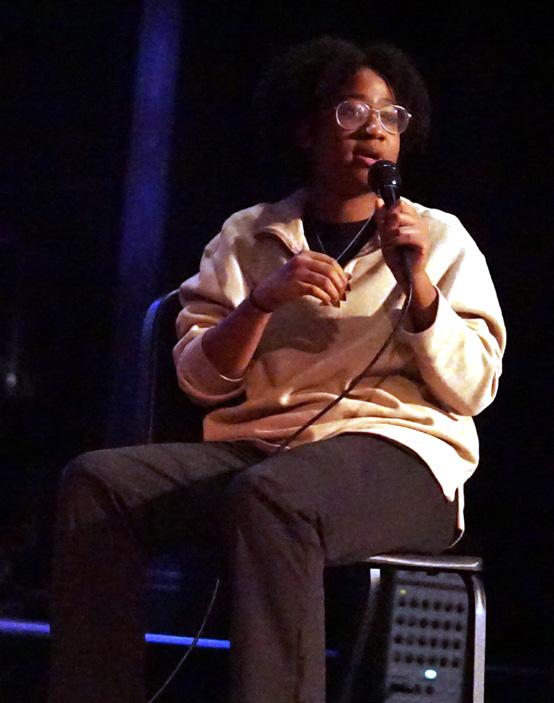

HALLWAY GALLERY SHOWCASES STUDENT ARTIST OF COLOR
Greeting students and staff as they walk into school, the gallery wall across from the main office is filled with art from African American artists here at McCallum, as well as featured artists of color renowned throughout the world for Black History Month. The Shield asked three of the showcased artists to share more about their works and the inspiration behind them. Here are the responses from freshman Sahara Cumberpatch, sophomore Montrel Beverley and senior Brooke Miller.
SAHARA CUMBERPATCH: “I used a lot of shapes and bright primary colors like red, yellow and blue. I also did a lot of black to make it stand out more, and a lot of shapes. I try and draw a lot of black people and people with natural hair because I don’t see that a lot, and I feel like I should just do that.” Photo by Josie Bradsby .
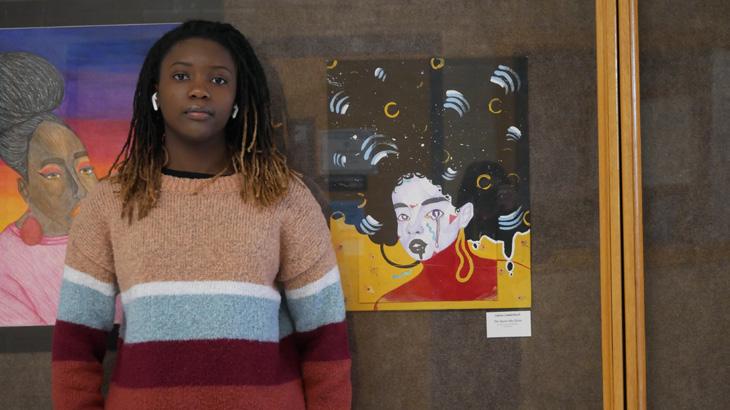

MONTREL WILLIAMS: “In elementary, I didn’t really have any friends, and the teacher was doing a project with pipe cleaners, and I just started messing around with pipe cleaners and over time I got better and better, and then I started making the figures, and, well that’s that.” Photo by Lydia Reedy. JUST SMART: Seniors Danielle Atwood, Lia Jones, Brooke Miller and Kyla Gibson, and junior Vivian Odoms volunteer to go on stage during Dr. Leonard Moore’s fourthperiod talk. Gibson said that being a person of color has impacted her experiences at school “In AP classes the teachers are always like, ‘Oh my God we love you, you’re so smart.’ But there’s always that stereotype of “you’re smart for a black person,” Gibson explained. “I just want to be smart for being smart.” Photo by Regan Sims.
IDENTITY CHANGED: Junior Taft Stansel, freshman Ron Wolleben and junior Corin Vandenberg join Dr. Leonard Moore’ on stage in the FABT during second period last Friday. “He brought a set of white kids and a set of black kids on stage to show that it doesn’t matter what nationality you were in Europe or Africa; in America you are just white or black,” Wolleben said. Photo by David Winter.
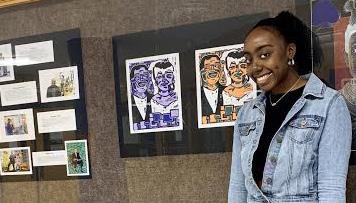
BROOKE MILLER: “What usually inspires me is my family. I do a lot of portraits, and if not, nature. I’m a [visual art] major and I’m also one of the ambassadors of the Fine Arts Academy, I’m also director for the fashion show, and I’m designing in the fashion show. I’m really excited [to be a featured artist].” Photo by Anna O’Keefe.










